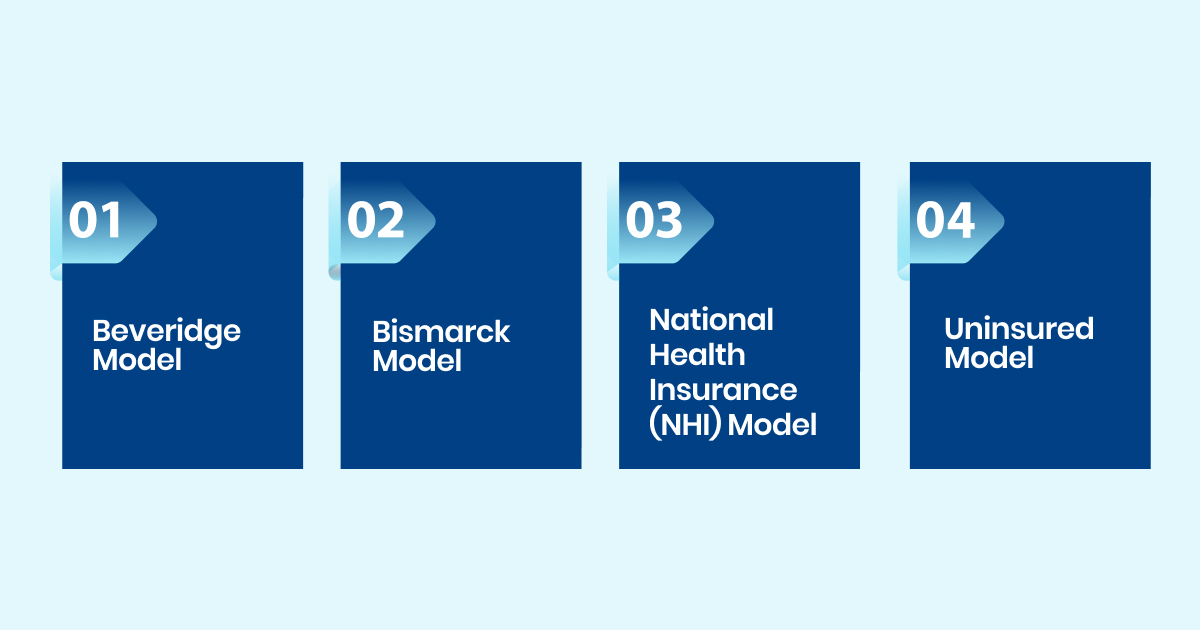.webp)
4 Basic Types of Health Care Systems and Their Structures
.jpg)
Healthcare is delivered differently around the world, shaped by each country’s unique political priorities, economic conditions, and cultural values. While the goal of providing effective medical care to people when they need it remains universal, the systems built to achieve that goal vary widely.
Understanding how these systems work is essential for anyone interested in global health, policy, or even the inner workings of healthcare delivery. Whether you’re a healthcare professional, student, or a policy analyst, among other roles, knowing the key structures that define care access, funding, and administration can give you a valuable perspective.
In this blog, we’ll explore the four basic types of healthcare systems that define how most nations organize their medical care. We’ll learn how each system is structured, who pays for care, how services are accessed, and the pros and cons of each model. We’ll also include real-world examples to illustrate how these systems function in practice, and how they affect healthcare quality, equity, and financial sustainability.
What makes a good healthcare system?
A good healthcare system meets the diverse needs of its population while ensuring high-quality care. According to the World Health Organization (WHO), several key qualities define an effective healthcare system:
- Safe and effective care: Services should be tailored to individual needs, considering personal preferences and values to provide the best outcomes.
- Timely access: Reducing wait times is crucial to prevent harmful delays and ensure patients receive the care they need when they need it.
- Equitable: Everyone, regardless of background or location, should have equal access to the healthcare services they require.
- Integrated services: A well-functioning system provides comprehensive care that spans a person's entire life, from prevention to treatment.
- Efficient: Resources are used wisely, maximizing benefits while minimizing unnecessary costs or waste.
The Four Main Types of Healthcare Systems
Healthcare systems differ widely across countries, influenced by each nation’s political, economic, and cultural landscape. These differences shape how care is funded, delivered, and accessed, ultimately affecting health outcomes and financial sustainability.
Most systems fall into one of four core models: the Beveridge, Bismarck, National Health Insurance (NHI), or Out-of-Pocket model. Each offers a unique approach to financing care and managing services, with varying levels of government involvement and private sector participation.

Let’s explore how each of these models works, their key strengths and challenges, and real-world examples of where they’re applied. We’ll also look at how these systems influence not just access to care, but also the administrative processes like billing and coding that support every healthcare interaction.
1. Beveridge Model
In the Beveridge model, healthcare is seen as a public service, funded entirely by taxes. This system is designed to ensure that all citizens have access to healthcare services, regardless of their ability to pay. The government plays a key role not only in financing healthcare but also in providing services. In many cases, healthcare facilities are government-owned, and healthcare providers are government employees.
Key Features:
- Publicly Funded and Operated: Healthcare services are funded through taxation, and most services are provided by government-run hospitals and clinics.
- Universal Access: Healthcare is available to all citizens without direct charges at the point of service.
- Government-employed Healthcare Providers: Most doctors and nurses are employed by the government, working within the public system.
- Emphasis on Preventive Care: The system often prioritizes preventive healthcare to keep overall costs low and improve public health.
Advantages:
- Universal Coverage: Every citizen is guaranteed access to healthcare, which helps reduce disparities in health outcomes across different populations.
- Lower Costs: With a single payer system, the government can control costs by negotiating prices with healthcare providers and pharmaceutical companies.
- Focus on Public Health: The emphasis on prevention helps reduce the need for expensive treatments by addressing health issues early on.
Challenges:
- Wait Times for Non-Emergency Care: Due to the high demand for services, wait times for non-urgent procedures can be long.
- Limited Choice: Patients may have less flexibility in choosing their healthcare providers, as government-run facilities offer most services.
- Potential for Underfunding: If the system is underfunded, it can lead to a shortage of resources, impacting the quality of care.
Real-life Example:
The United Kingdom's National Health Service (NHS) is one of the most well-known examples of the Beveridge model. While it offers universal healthcare, many people experience delays in accessing non-urgent services due to high demand. Despite these challenges, the system's focus on universal access and low-cost care is a significant benefit.
2. Bismarck Model
The Bismarck model, named after the German Chancellor Otto von Bismarck, relies on a system of health insurance that both employers and employees fund. Unlike the Beveridge model, the Bismarck system involves private insurance companies, known as "sickness funds," which are responsible for paying for healthcare services. The government regulates the system to ensure it remains affordable and covers everyone.
Key Features:
- Employer-Employee Contributions: Health insurance is funded through mandatory payroll deductions from both employers and employees.
- Private Healthcare Providers: Services are provided by private healthcare professionals and facilities, although they are reimbursed by the insurance funds.
- Regulated Insurance Market: The government ensures that insurance companies do not exclude people based on pre-existing conditions and that premiums are affordable.
- Comprehensive Coverage: The sickness funds cover a broad range of services, including doctor visits, hospital stays, and prescription drugs.
Advantages:
- Wide Provider Choice: Patients can choose their doctors and hospitals, which provides greater flexibility.
- High Quality of Care: Private providers are incentivized to maintain high standards of care to attract patients.
- Quick Access to Services: Wait times for essential services are generally short, as there is less government control over service delivery.
Challenges:
- Complexity of Multiple Insurance Providers: With several different insurance companies in the market, the system can be complex to navigate.
- Rising Premiums: The cost of premiums can increase, particularly in times of economic strain, creating a financial burden on both employers and employees.
- Administrative Costs: Managing multiple insurance providers leads to higher administrative costs compared to a single-payer system.
Real-life Example:
Germany's healthcare system is an example of the Bismarck model in action. In Germany, employees and employers contribute to "sickness funds," which then reimburse private healthcare providers for the services they deliver. While the system offers a high standard of care and short wait times, the complexity of managing multiple insurance plans can be challenging for some people to navigate.
3. National Health Insurance (NHI) Model
The National Health Insurance model is a hybrid of the Beveridge and Bismarck models. In this system, the government funds healthcare services through taxes but leaves the delivery of services to private providers. The government acts as the sole insurer, while healthcare providers remain private. This model offers a balance between public funding and private care delivery.
Key Features:
- Government as the Sole Insurer: The government funds healthcare through taxation, covering all citizens.
- Private Providers: Healthcare services are delivered by private providers, but the government reimburses them for the services they offer.
- Universal Coverage: Every citizen has access to healthcare, with the government ensuring that everyone is covered by insurance.
- Price Negotiation: The government negotiates prices for services and medications to control costs.
Advantages:
- Universal Access: Everyone is guaranteed healthcare coverage, regardless of their income level.
- More Choice than Beveridge: Since private providers deliver the care, patients often have more options for their healthcare needs.
- Lower Administrative Costs: With only one insurer, the government, there are fewer administrative costs compared to a multi-insurer system.
Challenges:
- Wait Times for Non-Emergency Care: Like the Beveridge model, wait times for non-urgent services can be long due to high demand.
- Varying Quality of Care: The quality of care can vary depending on the region or the specific provider, as private providers have different levels of funding and resources.
- Higher Taxes: To fund the system, taxes may need to be raised, which can be a point of contention for some citizens.
- Regulatory Complexity in Billing: Coding and billing systems must be carefully aligned with government regulations to ensure reimbursements, especially in regions with centralized insurance processing.
Real-life Example:
Canada operates a National Health Insurance system, where healthcare is funded by taxes but provided by private doctors and hospitals. While Canadians benefit from universal coverage, wait times for certain non-urgent services, such as elective surgeries, can sometimes be long.
4. Uninsured Model
In the Uninsured model, healthcare services are largely inaccessible unless individuals can pay for them directly out of pocket. This system, often seen in lower-income countries, lacks government-funded healthcare and relies on individuals to bear the full cost of medical services. There may be some limited government-provided services, but comprehensive care is generally available only to those who can afford it.
Key Features:
- Out-of-Pocket Payments: Healthcare services are paid for entirely by the individuals receiving them.
- Limited Government Involvement: While there may be some basic public health services, such as vaccinations, comprehensive care is usually not available to most of the population.
- Private Healthcare Providers: Healthcare is primarily provided by private doctors and hospitals, with no universal coverage.
Advantages:
- Minimal Government Control: There is no government intervention in healthcare, giving the market full control over prices and services.
- Flexibility for Providers: Healthcare providers set their prices and have the freedom to offer a range of services.
Challenges:
- Access Inequality: Only those who can afford healthcare receive it, leaving the majority of the population without adequate care.
- Financial Barriers: The cost of medical care can create significant financial hardship for individuals, particularly in emergencies.
- Limited Preventive Care: Preventive services, such as vaccinations or screenings, may be out of reach for many, leading to higher healthcare costs in the long run.
Real-life Example:
In many low-income countries, particularly in regions of sub-Saharan Africa and parts of South Asia, the uninsured model is prevalent. People who can afford private care receive treatment, while those who cannot are often left without access to basic health services.
How Global Healthcare Models Impact Medical Coding and Reimbursement
While healthcare systems differ in how they fund and deliver care, one universal constant remains: the need for accurate, compliant medical documentation and diagnosis coding. For health systems, billing teams, and coders, the structure of a country’s healthcare model directly influences how claims are submitted, reimbursed, and audited.
The table below compares the four primary healthcare models, not just in terms of who pays, but in how they impact medical billing, coding workflows, and reimbursement practices.
Conclusion
Healthcare systems around the world are shaped by different priorities. Some aim to provide universal care through public funding, while others rely on private insurance or individual payments. Each system presents its own balance of accessibility, efficiency, and cost control.
While the structure of care delivery varies, one critical requirement remains constant across all models: accurate, compliant medical documentation and coding. Whether operating under a nationalized system like the NHS or navigating multiple insurers as in Germany, healthcare organizations must ensure claims are coded correctly to secure reimbursement and reduce denials.
Simplify Global Coding and Documentation with RapidClaims
Whether you're working within a public health system, private insurance structure, or a hybrid model, RapidClaims ensures your clinical documentation supports accurate ICD-10 coding, meets payer standards, and remains audit-ready.
Our AI-powered tools like RapidCode and RapidScrub help revenue cycle and coding teams:
- Identify and correct documentation gaps
- Improve first-pass claim acceptance
- Stay compliant with evolving local and international coding guidelines
Ready to simplify your medical coding process?
Request a demo and see how RapidClaims enhances documentation accuracy, no matter which healthcare model you operate in.
FAQs
1. What are the four basic types of healthcare systems?
The four basic types of healthcare systems are the Beveridge model, the Bismarck model, the National Health Insurance (NHI) model, and the Out-of-Pocket model. Each model has its approach to funding, delivery, and accessibility of healthcare services.
2. How does the Beveridge model differ from the Bismarck model?
The Beveridge model is government-funded and operated, providing universal coverage through public healthcare facilities. In contrast, the Bismarck model relies on employer-employee contributions to private insurance funds, with healthcare provided by private doctors and hospitals.
3. What are the key advantages of the National Health Insurance (NHI) model?
The NHI model combines public funding through taxes with private healthcare delivery. It ensures universal coverage, provides more flexibility for patients in choosing providers, and maintains lower administrative costs compared to multiple private insurers.
4. Why is the Out-of-Pocket model considered the least equitable?
The Out-of-Pocket model places the financial burden of healthcare entirely on individuals. Only those who can afford to pay for services receive care, leading to significant disparities in access and health outcomes, particularly in low-income regions.
5. Which healthcare model provides the most flexibility for patients?
The Bismarck model and National Health Insurance (NHI) model provide more flexibility compared to other systems. Both allow patients to choose from a range of private healthcare providers, offering greater control over their care and treatment options.
6. How does the choice of healthcare model affect healthcare spending?
Healthcare models that rely on public funding, like the Beveridge and NHI models, generally control spending through government regulations and price negotiations. In contrast, systems like the Bismarck model can lead to higher administrative costs, and the Out-of-Pocket model may result in inefficient spending, as people only seek care when necessary.
%201.png)







